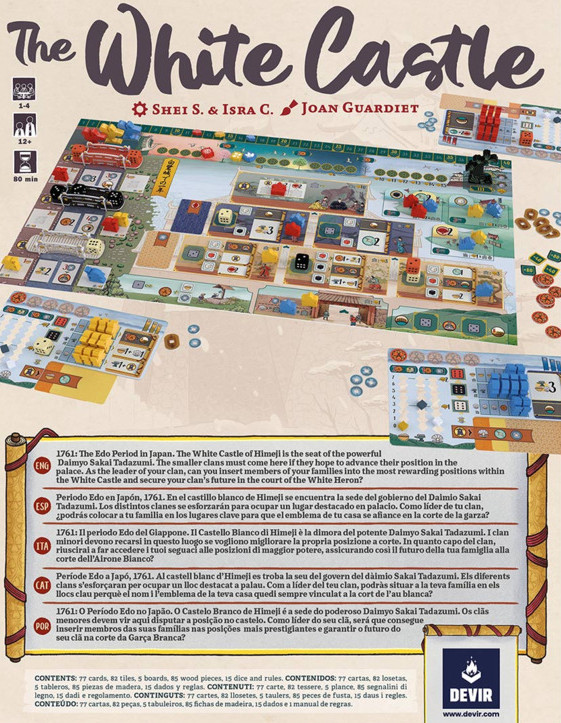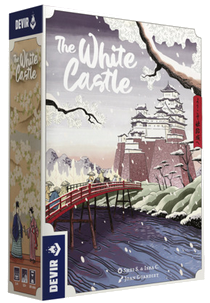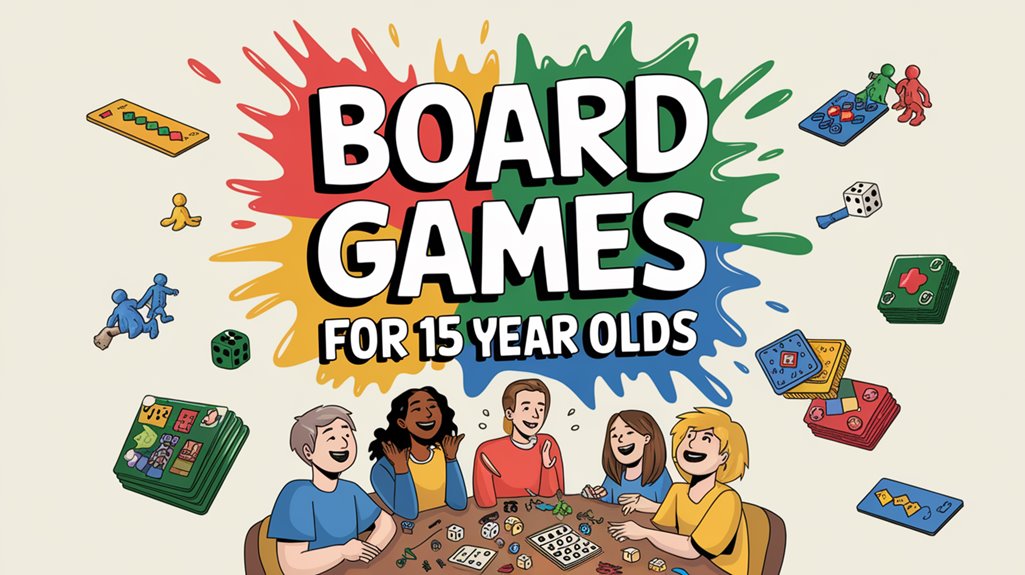The White Castle offers players a tightly designed experience within a nine-turn framework. Each decision carries significant weight as participants navigate the strategic terrain of worker placement and dice selection. The game’s interlinked mechanics reward careful planning while punishing inefficiency. Resource management presents constant tension between immediate needs and long-term objectives. The visual representation of Himeji Castle provides an elegant backdrop to the proceedings. Players must decide: will they master the delicate balance of courtier influence, garden harmony, or warrior strength?
Key Takeaways
- The White Castle combines worker placement, dice placement, and resource management across nine turns in a beautiful Himeji Castle setting.
- Strategic dice selection from the bridge mechanism dictates actions and resources, making each turn crucial.
- Players balance three roles—Courtiers, Gardeners, and Warriors—to create chain reactions that multiply productivity.
- Multiplayer mode offers a richer experience through player interaction compared to the challenging but somewhat mechanical solo play.
- High-quality components include standout dice bridge, character standees, and domain boards that enhance both gameplay aesthetics and functionality.
Basic Info of White Castle Game
In the domain of modern Eurogames, The White Castle stands as a strategic challenge that blends multiple mechanics into a unified experience. The game incorporates worker placement, dice placement, and resource management systems around a central board depicting Himeji Castle.
Players navigate through three rounds (nine turns total) selecting dice from a unique bridge mechanism, where values dictate available actions and resources. This core decision-making process forces players to optimize their choices to advance their clan’s standing.
Action cards add depth to the strategic environment, providing additional pathways to victory within the compact 60-90 minute playtime. While the White Castle board accommodates 1-4 players, community feedback suggests the multiplayer experiences deliver more balanced gameplay than solo play, which some find unfairly challenging. The visually appealing meeples improve the tactile engagement throughout this analytical euro experience.

The Nine-Turn Challenge: Making Every Action Count
At the heart of The White Castle’s tactical depth lies its strict economy of turns, providing players just nine opportunities across three rounds to execute their strategic vision. This limitation demands players maximize the impact of each action taken, making efficiency vital to success.
When selecting dice from the bridge, each strategic choice involves careful calculation—paying or earning the difference between die value and player board position. Dead turns can prove catastrophically wasteful in such a constrained framework.
Experienced players recognize the potency of combo actions, chaining die placements to amplify resource acquisition and scoring potential. The game rewards those who think several moves ahead, planning sequences that optimize limited opportunities.
The nine-turn structure creates natural tension, pushing players toward decisive action while punishing hesitation—a design that elegantly balances strategic depth with brisk gameplay.
Chain Reactions and Strategic Combos
The mastery of The White Castle emerges through skillful orchestration of chain reactions that transform single die placements into cascading sequences of actions. Players who excel understand that dice selection from bridges isn’t merely about individual values, but about creating pathways to execute multiple chained actions within a single turn.
Strategic placement of courtier meeples in the Castle can trigger Lantern Actions, which, when combined with standard actions, multiply a player’s productivity. This efficiency becomes critical given the game’s nine-turn limit. By leveraging action cards alongside carefully selected dice, players avoid dead turns and maximize each opportunity on the board.
The turn order creates natural tension as players must balance immediate dice utility against long-term strategic planning, ensuring each placement contributes to meaningful combo opportunities rather than isolated benefits.
The Art of Dice Bridge Selection
Central to mastering The White Castle is understanding the subtle dice bridge selection mechanism, which governs player actions and strategic possibilities throughout the game. This dynamic action drafting system requires careful decision-making when choosing dice from the lowest or highest values available.
Players navigate a calculated risk-reward framework: selecting lower-valued dice than board values necessitates paying the difference, while opting for higher values generates income. With only nine turns available, each player choice significantly impacts resource management. The mechanism brilliantly facilitates powerful combo executions that can dramatically alter one’s position.
The competitive atmosphere intensifies as strategic dice placement affects opponents’ available actions. This interplay between limiting others’ options while maximizing personal gameplay experience creates the tension that makes dice bridge selection both challenging and rewarding for those seeking strategic depth.
Courtiers, Gardeners, and Warriors: Role Management
Players must carefully position their meeples as Courtiers, Gardeners, and Warriors to maximize point-scoring opportunities across multiple game phases. Courtiers provide immediate victory points when sent to the castle while strategically unlocking Lantern Rewards that increase resource generation capacity. Warriors offer flexible utility through resource acquisition and domain protection, while Gardeners create end-of-round scoring potential when paired with prudent dice placement on the bridge.
Meeple Placement Strategy
Each successful campaign in White Castle hinges on strategic meeple allocation across three distinct roles. Players must navigate the nine-turn limit by optimizing courtier meeples for lantern actions, gardeners for end-round resource collection, and warriors for defense and victory points. Effective turns allocation between these roles facilitates gameplay efficiency and resource management.
| Role | Primary Function | Strategic Value |
|---|---|---|
| Courtiers | Trigger lantern actions | Facilitate combo-rich actions |
| Gardeners | Collect resources | Provide sustained income |
| Warriors | Defend castle | Convert investment into victory points |
The most successful strategies involve placing the dice to create synergistic combinations where courtier placements cascade into additional benefits. Players who balance their investment in warriors with resource generation typically outperform those who overcommit to a single approach, ensuring flexibility throughout the game’s compact duration.
Role-Specific Scoring Opportunities
Mastering the distinct scoring pathways of each role type unlocks White Castle’s strategic depth. The game presents three divergent approaches to victory point accumulation, each requiring deliberate tactical consideration.
Courtiers excel through castle placement, where their influence directly impacts end-game scoring. Strategic positioning of these figures yields substantial point advantages that can dramatically alter player standings. Meanwhile, Gardeners offer consistent resource generation plus additional scoring opportunities when dice remain on the bridge after rounds conclude.
Warriors contribute dual value through defensive actions that simultaneously protect the castle while generating points. Their effectiveness hinges on actions taken throughout gameplay, affecting both immediate and long-term scoring prospects.
Successful players develop integrated strategies leveraging each role’s strategic value, recognizing that balancing all three approaches typically outperforms specialization in any single role type.
Resource Economy: Paying vs. Earning
The core economic mechanism of The White Castle revolves around a calculated risk-reward system of dice value differentials. Players must weigh the cost of using lower-valued dice against the potential income from higher values, creating tension in every action selection.
| Dice Placement Scenario | Economic Outcome |
|---|---|
| Die < Requirement | Pay difference in resources |
| Die > Requirement | Earn money as bonus |
| Strategic Placement | Avoid dead turns |
| Lantern Actions | Boost income significantly |
| Multiple Actions | Maximize turn efficiency |
This economy demands precise resource management as players balance income generation against necessary expenditures. Courtier meeples strategically placed in the castle trigger rewarding actions through Lantern Actions, allowing savvy players to construct an efficient economic engine. The freedom to pursue multiple earning strategies creates distinctive pathways to victory through optimized dice placements and calculated risks.
Solo vs. Multiplayer Experience
Distinct differences emerge when comparing The White Castle’s solo mode to its multiplayer experience. The solo variant employs an AI card deck to dictate rival clan decisions, which preserves core mechanics but creates a fundamentally different strategic environment. Analysis of community feedback reveals a clear preference for multiplayer gameplay.
- Solo mode often creates relentless pressure that can feel unfair rather than challenging
- Multiplayer gameplay enables dynamic player decisions and interactive strategic planning
- The AI card deck maintains mechanical integrity but lacks the unpredictability of human opponents
- Player engagement and overall enjoyment ratings consistently favor multiplayer sessions
While solo play requires the same vigilance against dead turns as multiplayer, it cannot replicate the satisfaction derived from outmaneuvering human opponents. The freedom to adapt and react to other players’ strategies creates a richer experience that the structured AI cannot match.
Components and Production Quality
Production values in The White Castle demonstrate a thoughtful balance between functionality and aesthetic appeal. The standout dice bridge component not only boosts visual interest but serves the dice placement mechanics with precision. High-quality cardboard standees clearly differentiate between Gardeners, Warriors, and Courtiers, facilitating smooth gameplay.
Domain Boards feature an intelligent design that prevents resource cubes from sliding during play—a small but significant detail that elevates the gaming experience. While the rulebook effectively explains both multiplayer and solo variants, some may find the picture quality somewhat amateurish. Nevertheless, this medium-weight Eurogame delivers components that meet industry standards for its category. The compact box design offers practical storage without compromising on component quality, making The White Castle both visually appealing and functionally sound.




